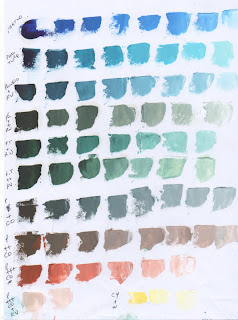Compostion
Square format , the canvas is divided into horizontal thirds with the profile of 2 embracing bodies intersecting all 3 thirds. The top 2 thirds have straight evenly spaced ( approx. 10 cm) vertical lines. The bottom third gives some sense of perspective as the lines on the viewers left are narrower and slightly angled in such a way as to suggest coming to the fore.Apart from the figures the only other discernable element are 2 arrows to the left of the figures - I am slightly unsure whether they are both directing the viewer to the left or not. There is a darker / warmer are in the bottom left hand corner possibly representing shadow?
Colour
The painting is predominantly of cool colouring . A very limited palette has been used with a predominance of blue - possibly prussian blue and pthalo.
The top third of the painting is a richly textured blue and is the darkest third by far. The other 2/3 comprises greys predominantly cool greys with a warmer grey and yellow in the bottom left hand corner. The warm colours in this corner certainly pulls my eye towards it.
The paint application suggests a lots of layering and texturing probably using palette knives or other devices.
Some colour mixing suggests that a similar palette may be created using pthalo blue , raw umber , cadmium orange and possibly cadmium yellow with titanium white.
This painting has a broad spectrum of tone . in my diagram I have indicated the broad tonal range using a scale of 1 (lightest) to 10(darkest). The centre of interest is around the shoulder area where there is also the greatest tonal range.
Conclusions
This painting has had a huge effect on me and my perception of art and its effect on the individual. My response to the painting had nothing to do with 'this is by a Master so must be great' but was entirely to do with a deep visceral reaction to the emotion that was transmitted from the painting to me. I can only speculate as to the artists intention in this piece. For me it is a purposefully ambiguous painting - it is a man and woman or two people of the same gender. The warmest part of the painting is in the shadow area - is this telling the viewer something? The significance of the arrows? - my interpretation is one of social rejection(leaving, exit, rejection, disproval). For me the painting represents parting, joining, emotion, devastation and joy - I could go on!
Using the colours discussed above I had a go at a 30x30cm version and the result is below







A deep and very impressive analysis of a painter little known in England.
ReplyDeleteJudy, forgive me for asking, but what is OCA? I just stumbled on this/your blog and am finding it wonderfully fascinating. I'm presuming it is some kind of art course? How are the pastels and Wallis going?
ReplyDeleteJudy, just looked OCA up....so now I understand. Hats off to you for your continued education in painting. Maggie L
ReplyDelete